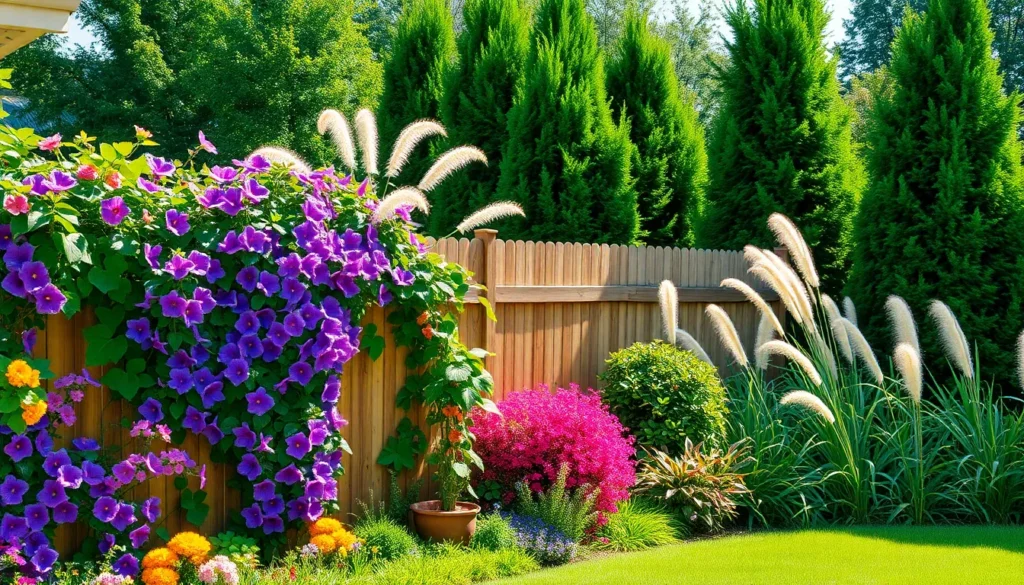We’ve all stared at that blank fence line wondering how to transform it from an eyesore into something spectacular. Backyard plants along fence areas offer incredible opportunities to create privacy screens, add vibrant colors, and maximize our outdoor space without very costly.
Whether we’re dealing with a chain-link fence that needs camouflaging or a wooden barrier that could use some softening, the right plant selections can completely revolutionize our yard’s appearance. From fast-growing climbing vines that’ll give us instant gratification to flowering shrubs that attract butterflies, there’s a perfect fence-line solution for every garden style and maintenance preference.
We’ll explore proven strategies that work in various climates and conditions, helping us choose plants that thrive against fences while solving common backyard challenges like noise reduction, neighbor privacy, and creating defined outdoor rooms.
Choose Fast-Growing Climbing Vines for Instant Privacy
Fast growing climbing vines transform bare fence lines into lush privacy screens within a single growing season. We’ve selected three top performing varieties that establish quickly while providing different benefits for your backyard fence plants.
Morning Glory for Seasonal Color
Morning glory vines create stunning seasonal displays with their trumpet shaped flowers blooming from summer through fall. These annual climbers reach heights of 6 to 10 feet in just one growing season, covering chain link fences and wooden structures with dense foliage. We recommend varieties like ‘Heavenly Blue’ and ‘Grandpa Ott’ for their reliable germination and vibrant color combinations.
Plant morning glory seeds directly along your fence line after the last frost date for your area. Seeds germinate within 5 to 10 days in warm soil, and the vines begin climbing immediately using their twining nature. Water regularly during establishment, then these drought tolerant plants require minimal maintenance while providing privacy coverage.
Clematis for Year-Round Structure
Clematis vines offer permanent woody structure with spectacular flowering displays that vary by cultivar selection. These perennial climbers return stronger each year, eventually reaching mature heights of 8 to 20 feet depending on the variety chosen. We suggest fast growing types like ‘Sweet Autumn Clematis’ and ‘Jackmanii’ for quick fence coverage and reliable performance.
Install sturdy support systems before planting clematis, as mature vines become quite heavy over time. Plant the crown 2 to 3 inches below soil level to encourage strong root development and multiple stem emergence. Clematis prefers cool roots and warm tops, so mulch heavily around the base while allowing upper growth full sun exposure.
Honeysuckle for Fragrant Coverage
Honeysuckle vines provide rapid privacy screening combined with intensely fragrant flowers that attract beneficial pollinators to your garden space. These vigorous perennial climbers can cover 10 to 20 feet of fence line annually once established. We recommend native varieties like ‘Major Wheeler’ and ‘John Clayton’ over invasive Japanese honeysuckle for responsible backyard plantings.
Establish honeysuckle plants 4 to 6 feet apart for complete fence coverage within two growing seasons. These adaptable vines thrive in various soil conditions and light levels, making them excellent choices for challenging fence locations. Prune annually after flowering to maintain desired size and prevent aggressive spreading into neighboring areas.
Plant Evergreen Shrubs for Year-Round Screening

Evergreen shrubs provide consistent privacy and visual appeal throughout all seasons, making them ideal companions to the climbing vines we’ve discussed. These dense, year-round plants create permanent screening answers that complement your fence line beautifully.
Arborvitae for Dense Barrier Formation
Arborvitae stands out as one of our most recommended evergreen shrubs for fence line privacy screening. These upright, narrow plants grow up to 2 feet per year and reach impressive heights of 15 to 20 feet, creating tall screens that save valuable backyard space. American Pillar and Emerald Green varieties maintain vibrant green color throughout winter months, ensuring your privacy barrier remains attractive year-round.
Dense foliage patterns make arborvitae particularly effective at blocking sight lines and reducing noise from neighboring properties. Full sun exposure helps these shrubs thrive, though they tolerate dry conditions once established in your industry. We recommend spacing them 3 to 4 feet apart along your fence line for optimal coverage and healthy growth patterns.
Boxwood for Formal Hedge Appeal
Boxwood shrubs deliver sophisticated, manicured appearances that transform ordinary fence lines into elegant industry features. Their dense evergreen foliage provides excellent privacy while offering precise shaping opportunities through regular pruning and shearing. Well-drained soil and partial to full sun conditions create ideal growing environments for these versatile plants.
Formal hedge designs become achievable with boxwood’s naturally compact growth habit and responsive pruning characteristics. Pest and disease resistance makes maintenance relatively straightforward when proper care practices are followed. We find boxwood particularly suitable for homeowners seeking uniform, professional-looking boundaries that enhance property values and curb appeal.
Privet for Low-Maintenance Boundaries
Privet shrubs offer practical answers for busy homeowners who want effective privacy screening without extensive maintenance requirements. Fast-growing characteristics allow these plants to quickly establish dense, leafy boundaries that block unwanted views and reduce wind exposure. Various soil types and light conditions accommodate privet successfully, from full sun to partial shade locations.
Minimal upkeep needs make privet an economical choice for long fence runs where consistent screening is desired. Natural boundary formation occurs through privet’s dense growth habit, creating effective privacy barriers with occasional trimming to maintain desired heights and shapes. We recommend privet for homeowners prioritizing functionality and ease of care over formal aesthetic appeal.
Select Flowering Perennials for Colorful Border Appeal
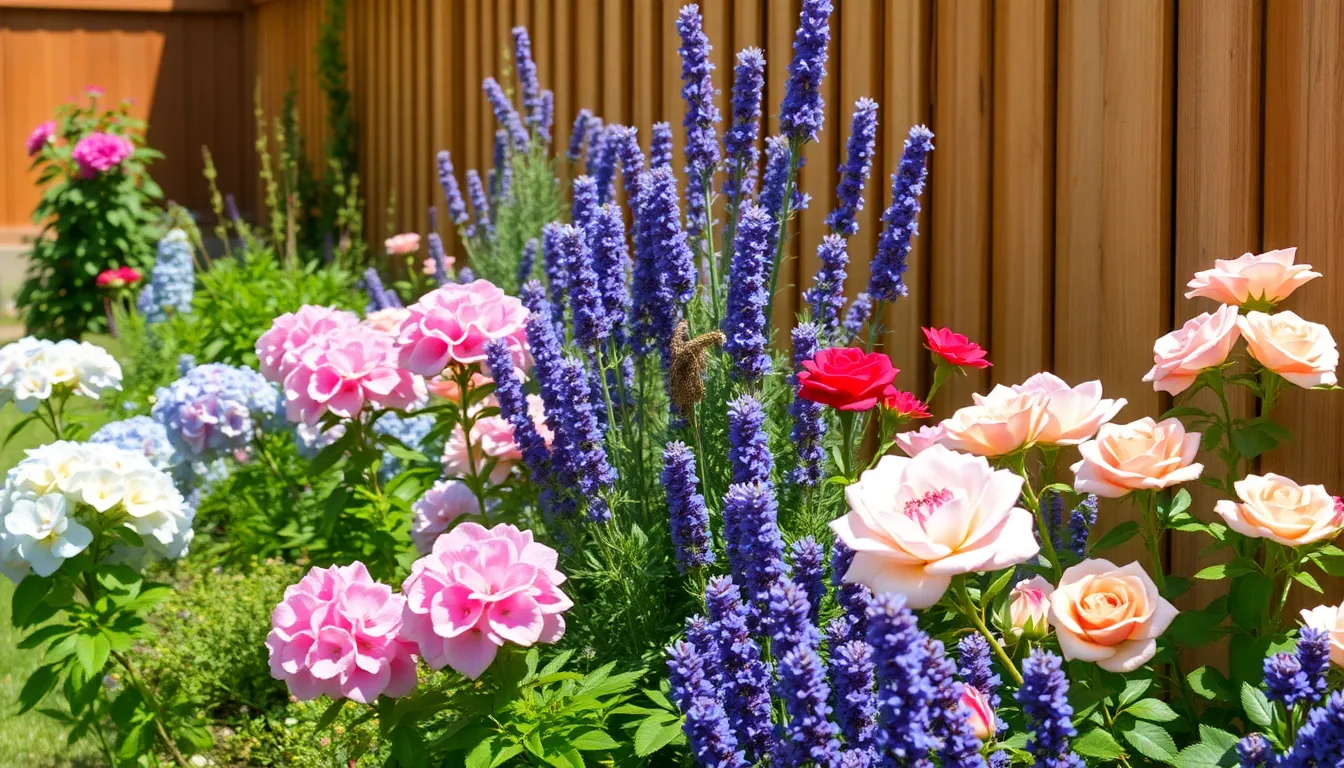
Transform your fence line into a stunning visual display with flowering perennials that deliver continuous color throughout the growing season. These reliable plants establish strong root systems and return year after year, making them cost-effective choices for long-term backyard beautification.
Hydrangeas for Summer Blooms
Hydrangeas create spectacular summer displays with their large, showy flower heads that come in pink, blue, and white varieties. We recommend positioning these classic perennials in partial sun to shade areas along your fence, where they’ll thrive in most temperate climates. Their voluminous blooms provide excellent coverage and create a lush backdrop that enhances privacy while adding sophisticated color to your border.
Plant hydrangeas 3-4 feet apart for optimal growth and air circulation. Water them consistently during dry periods, as they prefer moist but well-draining soil. Pruning should occur in late winter or early spring to encourage robust blooming throughout the summer months.
Roses for Classic Romance
Roses bring timeless elegance to fence plantings with their romantic appeal, intoxicating fragrance, and extended bloom periods. Modern shrub and industry roses offer superior disease resistance and repeat flowering capabilities, making them practical choices for busy homeowners. We suggest selecting varieties specifically bred for continuous blooming to maintain color along your fence from spring through fall.
Choose climbing or rambling rose varieties for vertical fence coverage, or plant shrub roses in front of shorter fences for layered appeal. Space roses according to their mature width, typically 3-6 feet apart depending on the variety. Regular deadheading encourages continued blooming, while annual pruning maintains shape and promotes healthy growth.
Lavender for Aromatic Benefits
Lavender combines beautiful purple flower spikes with aromatic foliage that releases its signature fragrance whenever brushed against. This drought-tolerant perennial prefers full sun exposure and well-draining soil, making it perfect for sunny fence borders that receive at least 6 hours of direct sunlight daily. Lavender attracts beneficial pollinators like bees and butterflies while deterring common garden pests.
Plant lavender 18-24 inches apart to allow for proper air circulation and prevent moisture-related issues. Harvest flower spikes in mid-summer for dried arrangements or culinary use. Prune lightly after flowering to maintain compact growth and encourage next season’s blooms.
Install Ornamental Grasses for Natural Movement
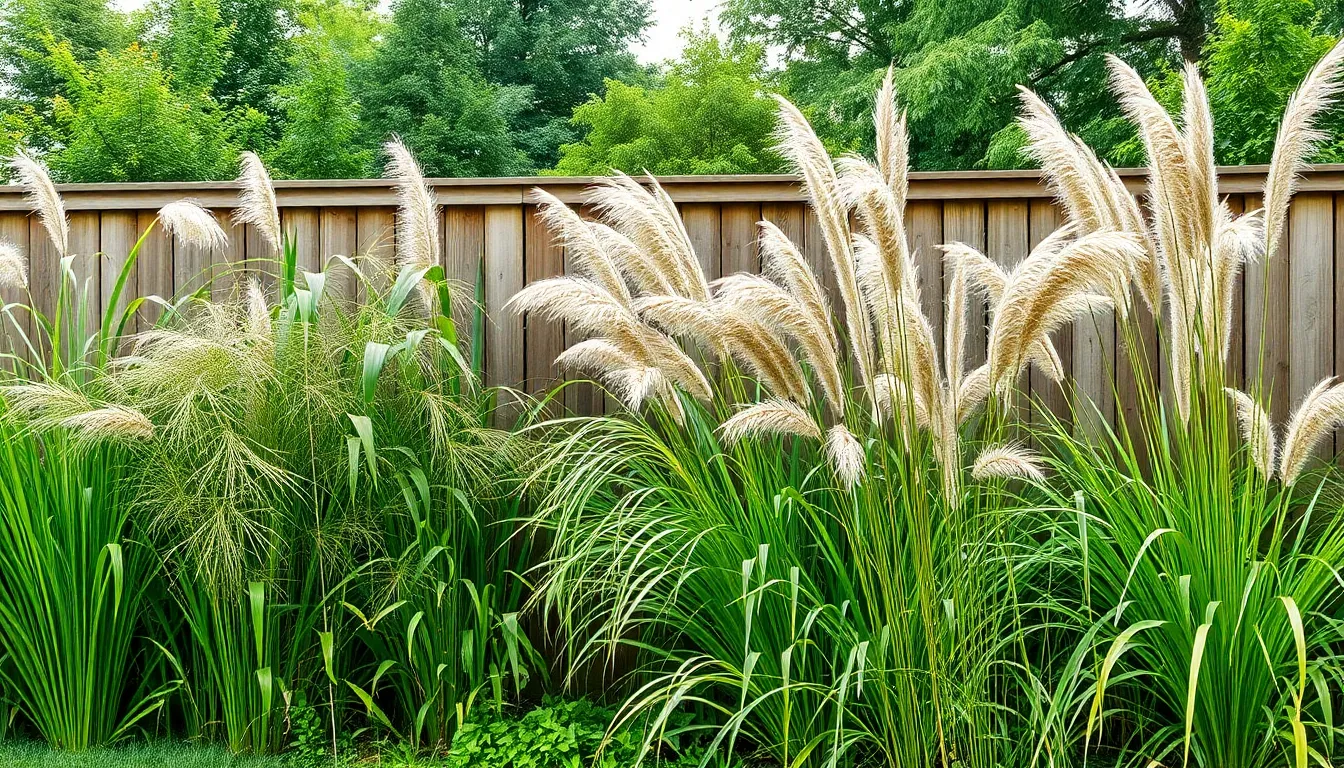
Ornamental grasses create elegant movement and texture along fence lines while providing year-round interest. We’ll explore three outstanding varieties that thrive in most conditions and add dramatic appeal to any backyard fence.
Bamboo for Dramatic Height
Bamboo grows quickly and tall, making it our top choice for adding privacy and dramatic vertical elements along fences. Clumping varieties prevent invasive spreading while creating dense natural screens that transform ordinary fence lines into tropical retreats.
Choose clumping bamboo species like Bambusa multiplex or Fargesia robusta for contained growth. Plant in spring when soil temperatures warm up, ensuring adequate space for mature width. Water regularly during establishment, then reduce frequency as bamboo develops extensive root systems. Mulch around plants to retain moisture and suppress competing weeds.
Dense foliage creates natural privacy barriers while adding Zen-like atmosphere to outdoor spaces. Position bamboo 3-4 feet from fence lines to allow proper air circulation. Prune older canes annually to maintain healthy growth and prevent overcrowding.
Fountain Grass for Soft Texture
Fountain grass features arching leaves and soft flower spikes that wave gently in breezes. We recommend Pennisetum setaceum for its graceful texture and ability to complement other fence line plantings.
Plant fountain grass in full sun locations with well-drained soil for optimal growth. Dig holes slightly wider than root balls at the same depth as containers. Water regularly when plants are young, then reduce frequency as they establish drought tolerance.
Soft flower spikes appear throughout growing seasons, creating continuous visual interest. Space plants 2-3 feet apart for natural clustering effect. Cut back to 6 inches in late winter before new growth emerges. Divide clumps every 3-4 years to maintain vigor and prevent overcrowding.
Miscanthus for Seasonal Interest
Miscanthus provides height and texture while serving as focal points along fence backgrounds. We value this large ornamental grass for its attractive plumes that appear in late summer and fall.
Select varieties like Miscanthus sinensis ‘Gracillimus’ or ‘Morning Light’ for compact growth habits. Plant in full sun locations where they’ll receive 6+ hours of direct sunlight daily. Prepare soil by adding organic compost to improve drainage and fertility.
Attractive plumes emerge in late summer, creating stunning seasonal displays through winter months. Water thoroughly after planting to settle soil and eliminate air pockets. Apply organic mulch around base to conserve moisture and suppress weeds. Divide clumps every 3-5 years in early spring to maintain healthy growth and prevent center dieback.
Incorporate Fruit-Bearing Plants for Functional Beauty
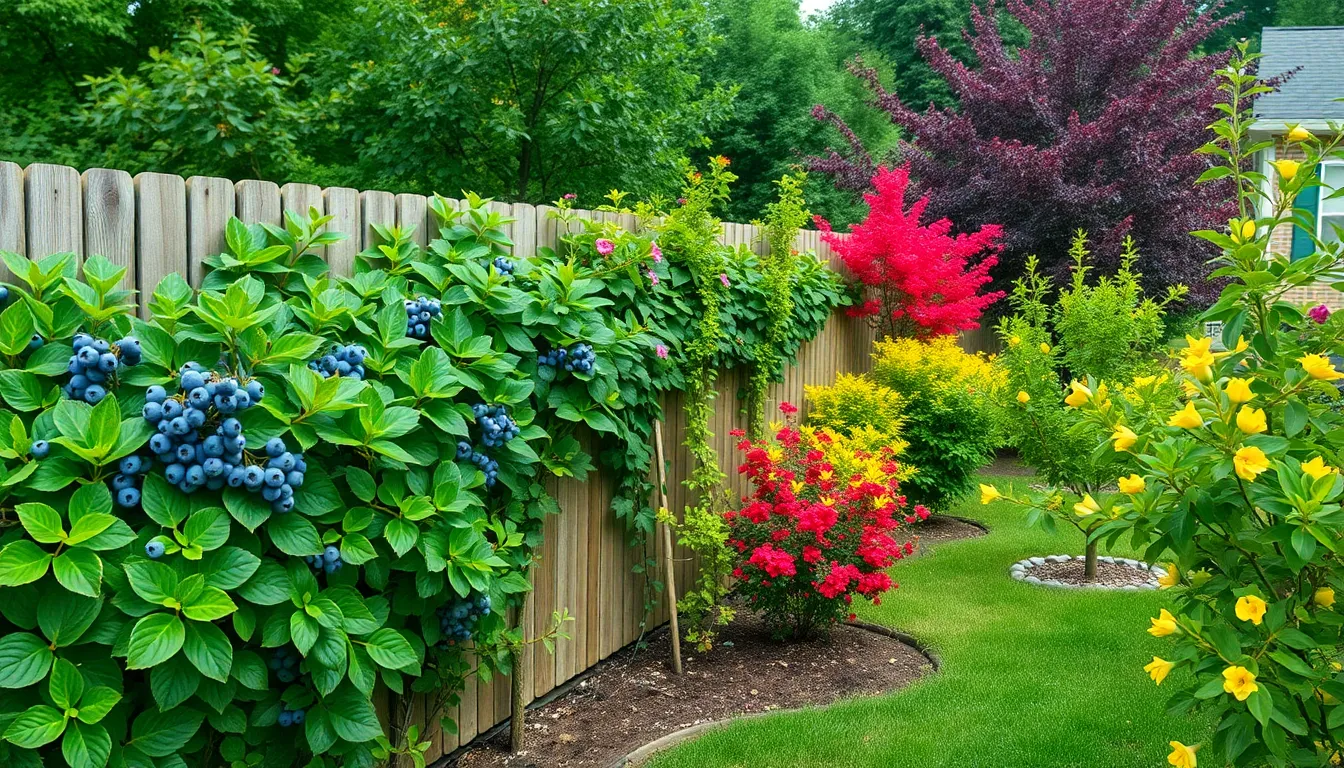
Fruit-bearing plants along fences maximize your outdoor space by combining stunning visual appeal with practical food production. These versatile plants create natural privacy screens while supplying fresh harvests right from your backyard.
Blueberry Bushes for Edible Landscaping
Blueberry bushes transform fence lines into productive edible landscapes that deliver both beauty and bounty. Dwarf varieties reach compact heights of 1.5 to 3 feet, making them perfect for smaller backyards, while highbush types grow 5 to 6 feet tall for larger spaces. These versatile shrubs produce delicious summer berries and create stunning fall displays when their leaves turn vibrant red.
We recommend planting blueberry bushes in full sun locations that receive at least 6 hours of daily sunlight. Acidic soil enriched with organic matter like shredded pine bark mulch mimics their natural forest environment and promotes healthy growth. When arranged in rows along your fence, these bushes form attractive edible hedges that support year-round garden structure.
Grape Vines for Vertical Growing
Grape vines excel at vertical gardening answers that use fence structures as natural support systems. These climbing plants save valuable ground space while producing clusters of juicy grapes throughout the growing season. Vines create lush green coverage that adds seasonal interest through their large decorative leaves and hanging fruit bunches.
Training grape vines properly along your fence ensures optimal air circulation and maximizes fruit production. Regular pruning maintains vine health while creating an organized, attractive appearance. These productive climbers transform plain fence lines into functional garden features that provide both ornamental value and fresh harvests.
Dwarf Fruit Trees for Space Efficiency
Dwarf fruit trees offer exceptional space efficiency for backyard fence plantings where ground area is limited. Varieties like lemon, cherry, apple, and plum trees reach manageable heights while providing multiple seasonal benefits including spring blossoms, summer fruit, and winter structure. These compact trees yield up to 50 pounds of fruit annually, making them incredibly productive additions to your fence line.
Self-pollinating varieties maximize harvests in smaller spaces, while compatible pairs can boost fruit production when planted together. We suggest placing dwarf fruit trees strategically along fence corners or gaps to create natural focal points. Their manageable size prevents overwhelming your outdoor space while delivering shade, beauty, and fresh produce throughout the growing seasons.
Design Layered Plantings for Maximum Impact
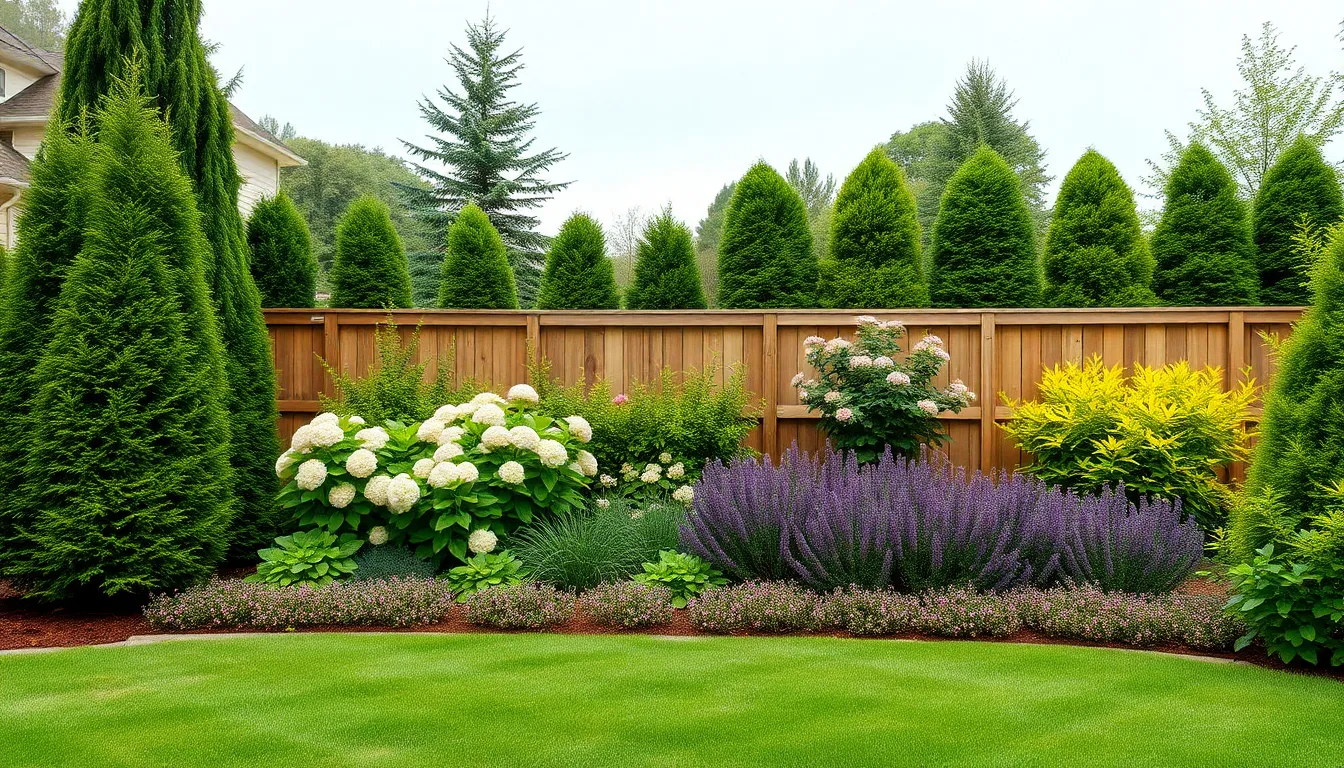
We recommend using a tiered structure that creates natural depth and visual interest along your fence line. This pyramid approach arranges plants from tallest at the back to shortest in front, ensuring each layer contributes to the overall industry design.
Tall Plants for Background Coverage
Trees and large shrubs serve as your privacy backbone, creating the essential screening effect that blocks unwanted views and reduces neighborhood noise. We position these tallest specimens directly against the fence to establish a green wall foundation.
Evergreen options like arborvitae and large junipers provide year-round coverage while maintaining their dense structure through all seasons. These tall plants typically reach 8-15 feet in height, creating substantial privacy barriers.
Ornamental grasses such as bamboo or miscanthus offer another excellent tall layer option, providing movement and texture while growing quickly to fill vertical space. Clumping bamboo varieties prevent invasive spreading while delivering rapid coverage.
Medium Plants for Middle Transition
Flowering shrubs create the essential bridge between your tall background plants and low ground cover, adding color bursts and textural variety to the middle zone. We select plants that typically reach 3-6 feet in height for this transitional layer.
Hydrangeas and rose bushes excel in this middle position, offering spectacular blooms that draw the eye while softening the transition from tall to short plantings. These medium-height options provide seasonal color changes and fragrant benefits.
Perennial plants like lavender and smaller ornamental grasses fill gaps beautifully while requiring minimal maintenance once established. Their consistent height and spreading habits create natural fullness in the middle layer.
Ground Cover for Finishing Touches
Low-growing plants complete your layered design by covering bare soil and providing a polished foundation that ties all elements together. We choose ground covers that stay under 12 inches tall for maximum impact.
Creeping thyme and sedum varieties suppress weeds naturally while adding color and texture at ground level. These hardy options spread gradually to fill empty spaces without overwhelming other plants.
Ornamental ground covers like creeping phlox or ajuga offer seasonal flowering at the base level, creating colorful carpets that enhance the overall planting scheme. Their low maintenance requirements make them perfect finishing touches for busy homeowners.
Consider Maintenance Requirements for Long-Term Success
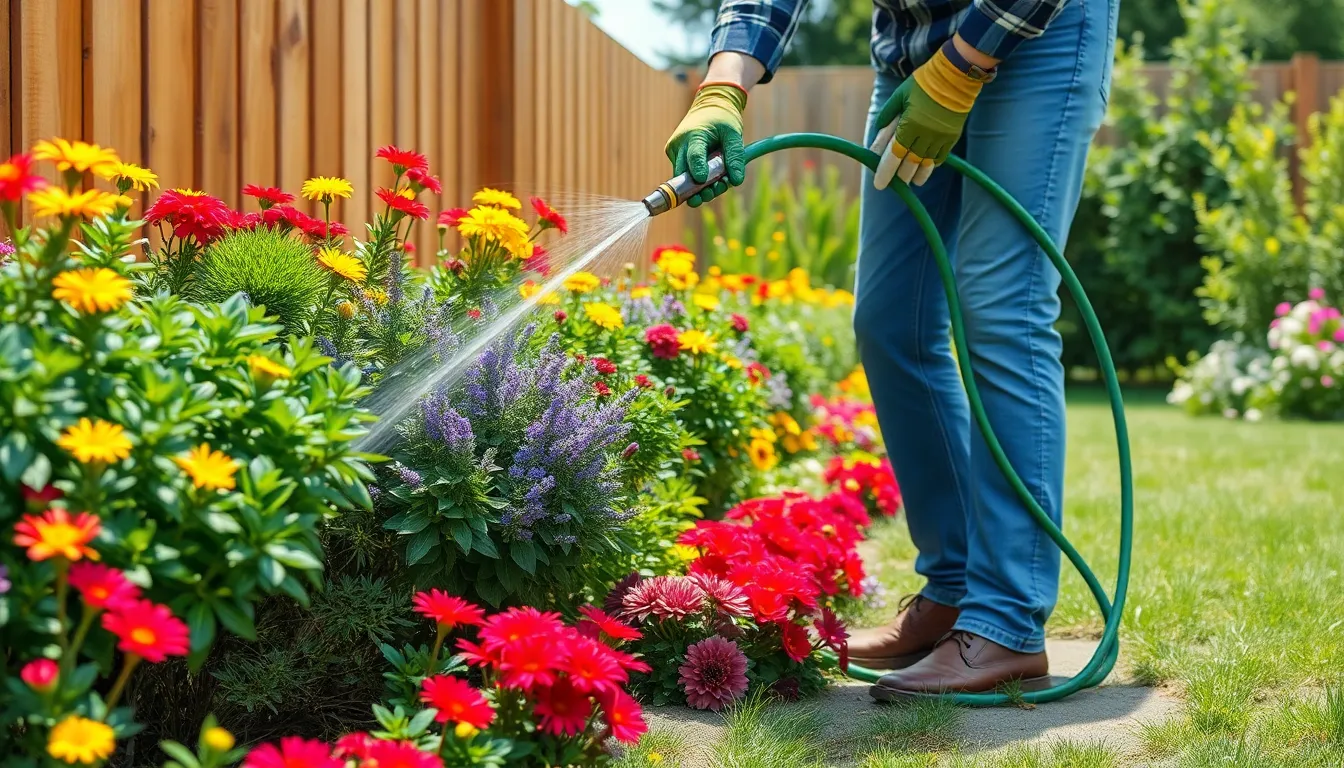
Planning your fence line garden means thinking beyond the initial planting phase. Success depends on establishing sustainable care routines that keep both plants and fencing in excellent condition for years to come.
Watering Needs for Different Plant Types
Different plants require varying watering approaches to thrive along fence lines. Shrubs and perennials benefit from deep, consistent watering, especially during dry spells when their root systems need adequate moisture penetration. We recommend adjusting watering frequency seasonally based on rainfall and temperature patterns to prevent both over and under watering situations.
Deep watering encourages strong root system development and improves overall drought tolerance in your fence line plants. Morning watering sessions work best since they allow plants to absorb moisture before heat stress occurs during peak daylight hours. Established plants typically need less frequent but more thorough watering than newly planted specimens.
Pruning Schedules for Healthy Growth
Pruning maintains plant shape while preventing overgrowth that can strain or damage fence structures. Regular trimming reduces the risk of branches growing into fence materials and causing structural issues over time. We suggest establishing pruning schedules based on each plant’s growth rate and flowering patterns.
Deadheading spent blooms encourages new growth cycles and prolongs flowering periods throughout the growing season. Spring pruning works well for most flowering shrubs, while evergreens often benefit from light trimming in late summer. Climbing vines require frequent attention to prevent them from overwhelming fence support systems.
Seasonal Care for Optimal Performance
Seasonal maintenance tasks include mulching, fertilizing, and monitoring both plant health and fence condition during weather transitions. We recommend cleaning fences and surrounding plants every six months to remove mildew or fungal buildup using gentle scrubbing techniques or appropriate fungicidal treatments.
Spring preparation involves checking for winter damage and refreshing mulch layers around plant bases. Summer care focuses on consistent watering and pest monitoring, while fall tasks include removing debris and preparing plants for dormancy periods. Winter inspections help identify any structural issues before they become major problems.
Spacing plants slightly away from fence materials allows proper airflow circulation, which helps prevent mold and rot development that can affect both vegetation and fencing components.
Plan for Proper Spacing and Growth Patterns
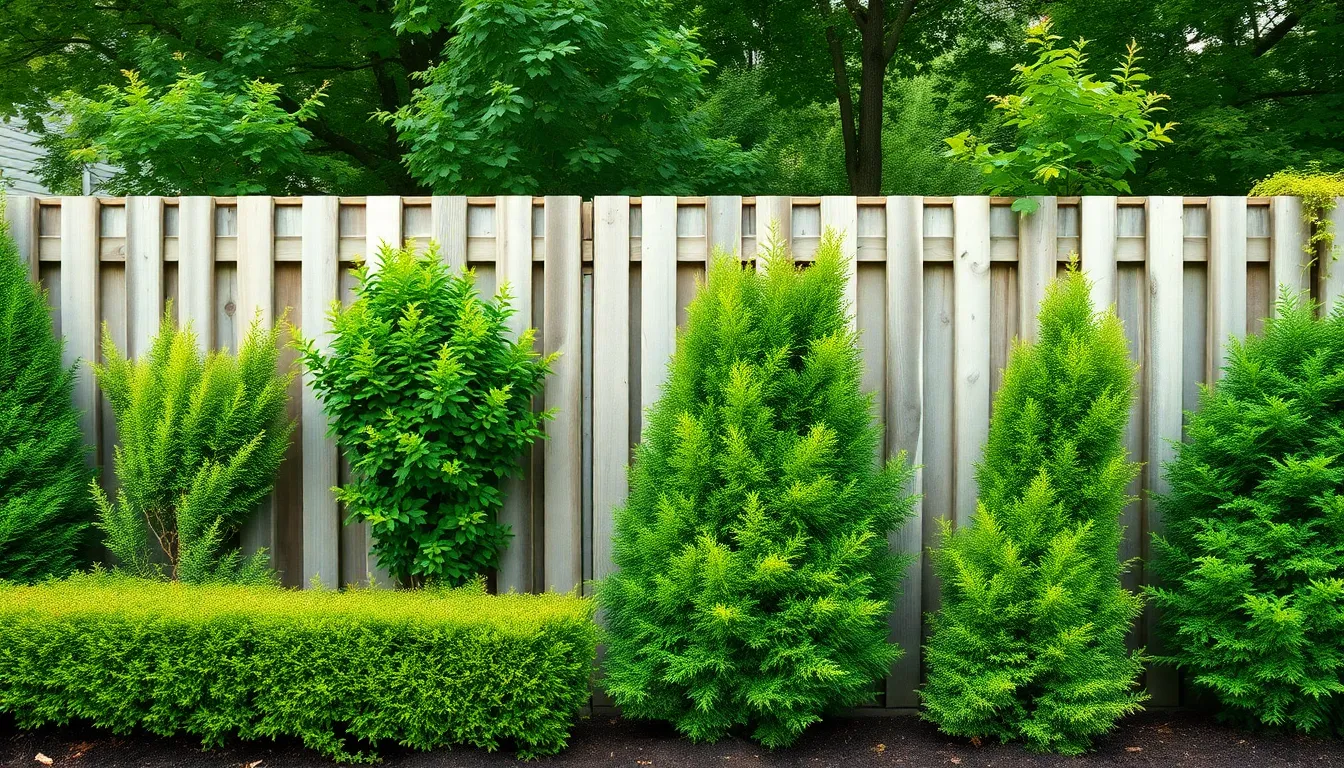
Strategic plant placement along your fence line requires careful consideration of mature plant sizes and growth habits. We’ll guide you through the essential measurements and calculations to ensure your backyard plants thrive without causing structural conflicts.
Measuring Distance from Fence Structure
Distance from your fence structure should accommodate both the plant’s root zone and canopy spread at maturity. We recommend allowing adequate clearance to prevent damage to both the fence and the plant as it develops over time.
Key measurements to consider:
- Root zone expansion area
- Mature canopy width
- Maintenance access space
- Airflow requirements
Proper clearance ensures you can maintain your fence easily while reducing moisture buildup that leads to fungal diseases. We’ve found that accounting for airflow between plants and fence materials prevents mold and rot issues that can damage both elements.
Calculating Mature Plant Dimensions
Plant spacing calculators available through online tools help you input area length and width to determine how many plants you need. We use these calculations to estimate appropriate distances between individual plants based on their mature dimensions.
Essential dimension factors:
| Plant Type | Spacing Formula | Example |
|---|---|---|
| Standard hedges | Half of mature width | 6-foot mature width = 3-foot spacing |
| Low hedges (under 5 feet) | Two-thirds of intended height | 3-foot hedge = 2-foot spacing |
| Desired hedge height | Three-quarters of mature height | 10-foot mature plant = 6-7 foot hedge |
Consider both mature width (spread) and height of each plant species to prevent overcrowding and competition for light and nutrients. We calculate these dimensions during the planning phase to avoid costly replanting later.
Avoiding Root System Conflicts
Root systems require careful selection to prevent aggressive invasion of fence foundations or underground utilities. We choose plants with moderate root growth patterns that won’t compete intensely with neighboring plants or harm fence structures.
Root management strategies:
- Select species with non-invasive root systems
- Space plants to allow adequate root expansion
- Plan for underground utility locations
- Consider soil drainage patterns
Species like Leylandii and Laurel work well when planted 2-3 feet apart for shrubs, balancing healthy growth with effective root management. We space these plants so their roots have sufficient room to grow without creating foundation or utility conflicts that could require expensive repairs.
Conclusion
Creating a stunning fence line garden transforms our outdoor spaces into private retreats while maximizing every square foot of our backyard. We’ve explored how the right combination of climbing vines evergreen shrubs flowering perennials and ornamental grasses can address both aesthetic and functional needs.
The key to success lies in thoughtful planning and proper spacing. When we consider mature plant sizes root systems and maintenance requirements from the start we create gardens that thrive for years without compromising our fence structures.
Remember that layered plantings offer the most dramatic impact while fruit-bearing options add practical value to our industry investment. With consistent care and attention to seasonal needs our fence line gardens will provide privacy beauty and enjoyment throughout every season.
Frequently Asked Questions
What are the best fast-growing climbing vines for fence privacy?
The top three fast-growing climbing vines for instant fence privacy are Morning Glory, Clematis, and Honeysuckle. Morning Glory provides seasonal color with trumpet-shaped flowers and quick coverage. Clematis offers year-round structure with stunning blooms but requires sturdy support. Honeysuckle delivers rapid coverage, fragrance, and attracts pollinators, making it excellent for transforming bare fence lines quickly.
Which evergreen shrubs work best for year-round fence screening?
Arborvitae, Boxwood, and Privet are the top evergreen shrubs for year-round fence screening. Arborvitae creates dense privacy barriers with impressive height and noise reduction. Boxwood offers a formal hedge appearance with easy maintenance through pruning. Privet is perfect for busy homeowners seeking low-maintenance options, as it establishes quickly and requires minimal upkeep throughout the seasons.
How do I create colorful borders along my fence line?
Create colorful fence borders using flowering perennials like Hydrangeas, Roses, and Lavender. Plant Hydrangeas in partial sun to shade areas for spectacular summer blooms. Choose modern rose varieties for disease resistance and continuous flowering. Use Lavender in sunny spots for aromatic benefits and drought tolerance. Each plant requires specific care guidelines for vibrant, lasting displays.
What ornamental grasses add texture to fence lines?
Bamboo, Fountain Grass, and Miscanthus are excellent ornamental grasses for adding natural movement and texture along fences. Bamboo provides rapid growth and dense screening with clumping varieties preventing invasiveness. Fountain Grass offers soft texture and graceful flower spikes in full sun. Miscanthus creates attractive seasonal plumes and requires full sun with well-drained soil for optimal growth.
Can I grow fruit plants along my fence for functional beauty?
Yes, fruit-bearing plants like blueberry bushes, grape vines, and dwarf fruit trees work excellently along fences. Blueberry bushes transform fence lines into productive edible landscapes. Grape vines excel at vertical gardening, providing ornamental value and fresh harvests. Dwarf fruit trees offer space efficiency with seasonal benefits, making them perfect for smaller backyards while maximizing outdoor space functionality.
How should I design layered plantings along my fence?
Design layered plantings using a tiered structure from tallest at back to shortest in front. Place tall evergreen trees and large shrubs as the privacy backbone, medium-height flowering shrubs like Hydrangeas in the middle, and low-growing ground covers like creeping thyme in front. This approach creates natural depth, visual interest, effective screening, and ensures seasonal color throughout the year.
What maintenance do fence line plants require?
Fence line plants need consistent deep watering, especially during dry spells, preferably in the morning to prevent heat stress. Regular pruning maintains plant shape and prevents overgrowth that could damage fence structures. Seasonal care includes mulching, fertilizing, and monitoring plant health. Space plants away from fence materials to promote airflow and prevent mold and rot issues.
How do I properly space plants along my fence line?
Measure distances from fence structures to accommodate root zones and canopy spreads. Consider root zone expansion, mature canopy width, maintenance access, and airflow requirements. Use plant spacing calculators based on mature plant dimensions to avoid overcrowding and resource competition. Select plants with moderate root growth patterns and ensure adequate spacing to prevent damage to fence foundations.

